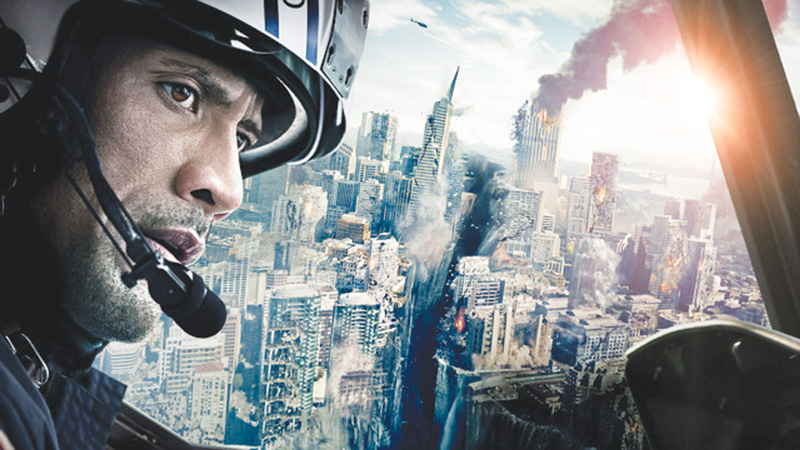
San Andreas – Film Review

The arrival of California’s next major earthquake along the notorious San Andreas fault, is looming and scientists Dr. Lawrence Hayes (Paul Giamatti), and Dr. Kim Park (Will Yun Lee) are working on a formula that will allow scientists to predict the coming of any earthquake.
Their calculations and readings are accurate until one scientist suddenly find himself right in the middle of the danger as it arrives. Ray Gaines (Dwayne Johnson) is an Los Angeles Fire Department search-and-rescue helicopter pilot. Somewhere between Los Angeles and San Francisco, his estranged wife, Emma (Carla Gugino), and daughter, Blake (Alexandra Daddario), are also caught in the immanent danger. Gaines must navigate the destruction to bring his family to safety.
Quite a bit of buzz has been surrounding this movie. But right off the bat, you get a sense that by no means did the filmmakers create this film to express a unique story. From looking at the structure of the film, San Andreas is intended for bigger things, apparently blockbuster status.
But blockbusters do not really make for compelling stories, in my opinion. And this story has your typical cookie cutter structure where your classic hero is the macho man of few words, who is big on action and can get just about any job done.
“The chosen one” for this particular role is, of course former WWE star Dwayne Johnson (aka The Rock). The Rock has featured in movies like this before so if it seems as if this role was made for him, it really is no surprise. Throw in some one-liners and a few good angles of his face and you have your archetypal champion. The whole movie is basically just a set up for Mr Johnson’s character to step in with his beefy bravado.
But the movie seems to express more of an idea or a recurring theme than anything, which is: never give up. In that way, I think that this movie’s clean formulaic structure really allows for the theme to be more prominent.
Although a tad cliché, the theme is strongly portrayed, both through the characters and the acting. Each character they focus on, however cliché they may be, is a valuable character in the story. Their success or downfall depends on every last bit of chance there is available, where every push to survive may be that final stretch. Through that sense of urgency, we experience the familial bond. Through the cohesiveness of Blake and her new friends, Ben (Hugo Johnstone-Burt) and Ollie Taylor (Art Parkinson), as well as Ray and Emma, we get to grasp how critical it is to work together. And the scientists help us understand the nature of this disaster so that we can really process the threat that it implies. We get carried through the movie by each person’s pursuit for survival and the intimacy that this crisis imposes.
But if there is one thing above all that gives the story its strength, it is the imagery. All the scenes are so vivid and very effective in creating a closer connection between what we are experiencing as the viewer and the danger that is happening throughout the film. The shots are also very dynamic, from the more intimate medium camera angles to aerial shots so that you can experience the bigger picture. In this sense I think you get a wholesome package: not only do you get to experience what is going on, but you get to be removed from it enough to see it in its entirety.
However, this film is a bit of a no-brainer if you ask me; any human being can follow and sympathise with a story like this. It is like taking pictures of babies; of course people will think they are cute. The overall fate of the characters is obvious, making for quite a boring story that is only saved by its near misses and skin-of-the-teeth action sequences. Although this movie does arouse a lot of suspense, where the occurrences are quite thrilling, nothing that happens is all that surprising. If this movie gets a pass, it is only because the makers know about the tried and tested formula that seems to work every time.













































